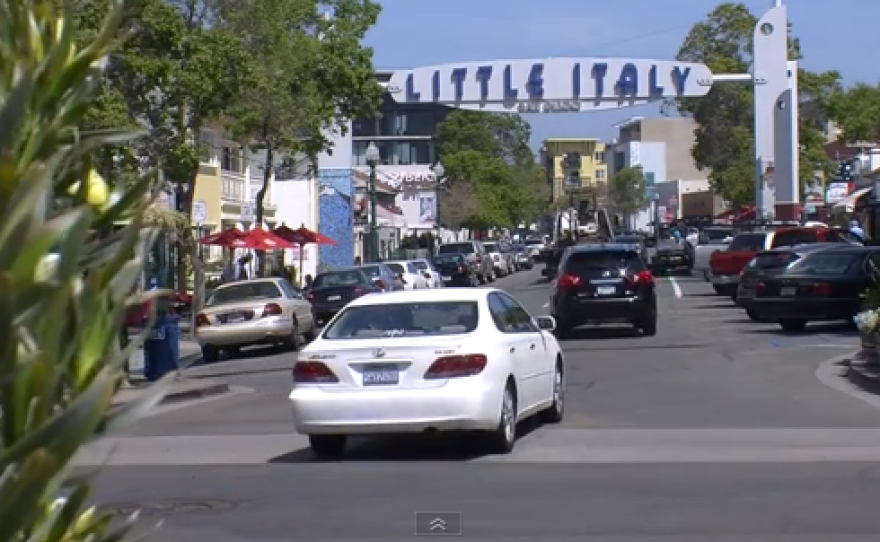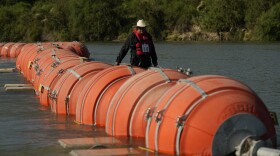Little Italy lies just north of downtown where its main street, India, is lined with cafes and new condo developments. Not many of the old Italian families remain. But Lou Palestini comes back a lot to visit.
“I grew up in that two-story house, the red-colored house over there,” he told me one weekday while standing on the corner of India and Fir streets. “My grandmother lived upstairs.”
Little Italy has changed a lot since Palestini was born in 1942, and the collapse of the tuna fishing industry wasn’t the only thing that caused its original residents to flee the neighborhood. About 40 years ago, the I-5 freeway tore though the area.
“What that freeway did to us… It cut us in half,” Palestini added.
Freeways move traffic. They can also divide and devastate urban neighborhoods. And Little Italy wasn’t the only near-downtown neighborhood that was devastated when Interstate 5 came to downtown San Diego.
“It killed Middletown. It killed, for a while, Little Italy. It killed Barrio Logan,” said Marco Li Mandri, president of New City America. “The S-curve basically goes around downtown, so it didn’t hurt commercial properties. It went through neighborhoods”
A lot of damage has been done. But there is something you can do about these deep gouges in the urban landscape. Vicki Estrada, president of Estrada Land Planning, spoke to me as she pointed to a stretch of I-5, between downtown and Balboa Park. She told me to imagine it covered by a freeway lid.
“Instead of seeing all this concrete and hearing all this noise, we could see a park, with trees and grounds and sports fields, perhaps,” she said. “Or even a series of shops and restaurants.”
A freeway lid is a concrete shelf that covers a sunken freeway, allowing development on top of it. San Diego’s Centre City Development Corporation (CCDC) developed a downtown development plan that called for a freeway lid over Interstate 5, between 3rd and 8th avenues.
If you go to Interstate 15, in City Heights, you don’t need your imagination to see what they can do.
Here, a freeway lid, completed by CALTRANS a dozen years ago, is home to a park with open fields, picnic benches and playgrounds. You can stroll from east or west across City Heights and not realize car traffic is moving below you at a mile a minute.
One major freeway lid is in the planning stage in Los Angeles. “Park 101” is a proposal to cap several blocks of Highway 101, near Union Station downtown. Doug Failing, with LA Metro, says freeway lids are a way to turn noisy urban ruts into useful public space.
“(You’re) able to capture back the value of that airspace, above those freeways, and being able to put that back in the public hands,” he said.
So why not cap all our sunken freeways to create parks and reconnect neighborhoods? Well, putting a lid on just one block of I-15 in City Heights cost $70 million 15 years ago. The cost estimate, for capping the I-5 between downtown and Balboa Park, is just under $300 million.
Li Mandri was born in Little Italy and he’s spent years working on the neighborhood’s redevelopment. He argues the cost of capping a freeway is prohibitive, and money in City Heights would have been better spent buying land and creating linear parks alongside Interstate 15.
“If you’re looking to maximize green area and parks within the mid-city area, which is probably the most under-parked area in the city, I think this was not the way to do it,” he said.
Li Mandri gives the example of Ward Canyon Park, just north of the City Heights freeway lid at Adams Avenue and I-15, as a better investment, and a park that gets more public use. Developing this park cost only $1.5 million. Li Mandri says acquiring the land in the 1990s probably cost less than $5 million.
Estrada said, depending on circumstances, the high cost of a freeway lid may be worth it. She adds that her great-grandmother owned a home in Sherman Heights that was demolished to make room for I-5, and the plans for freeway lids downtown are visionary.
“I think it’s a great vision that would go a long way to reconnecting the neighborhoods that were severed many years ago by the freeway,” she said.
Seen in another way, urban freeways don’t really destroy neighborhoods. They redefine them. Little Italy, now bordered by Interstate 5 to the east, is smaller and less family-oriented than it used to be. But it’s also bustling and prosperous, thanks to years of redevelopment.
You couldn’t build a freeway lid here because, in Little Italy, the I-5 is elevated, not sunken. Lou Palestini also wonders – even if you could reconnect his old neighborhood – what would be the point.
“After so many years, being divided, what are you going to bring back?” he asked. “Everybody’s made their own ways again. You know what I’m saying?”
Like it or not, progress and the I-5 have changed the face of this old Italian community.






